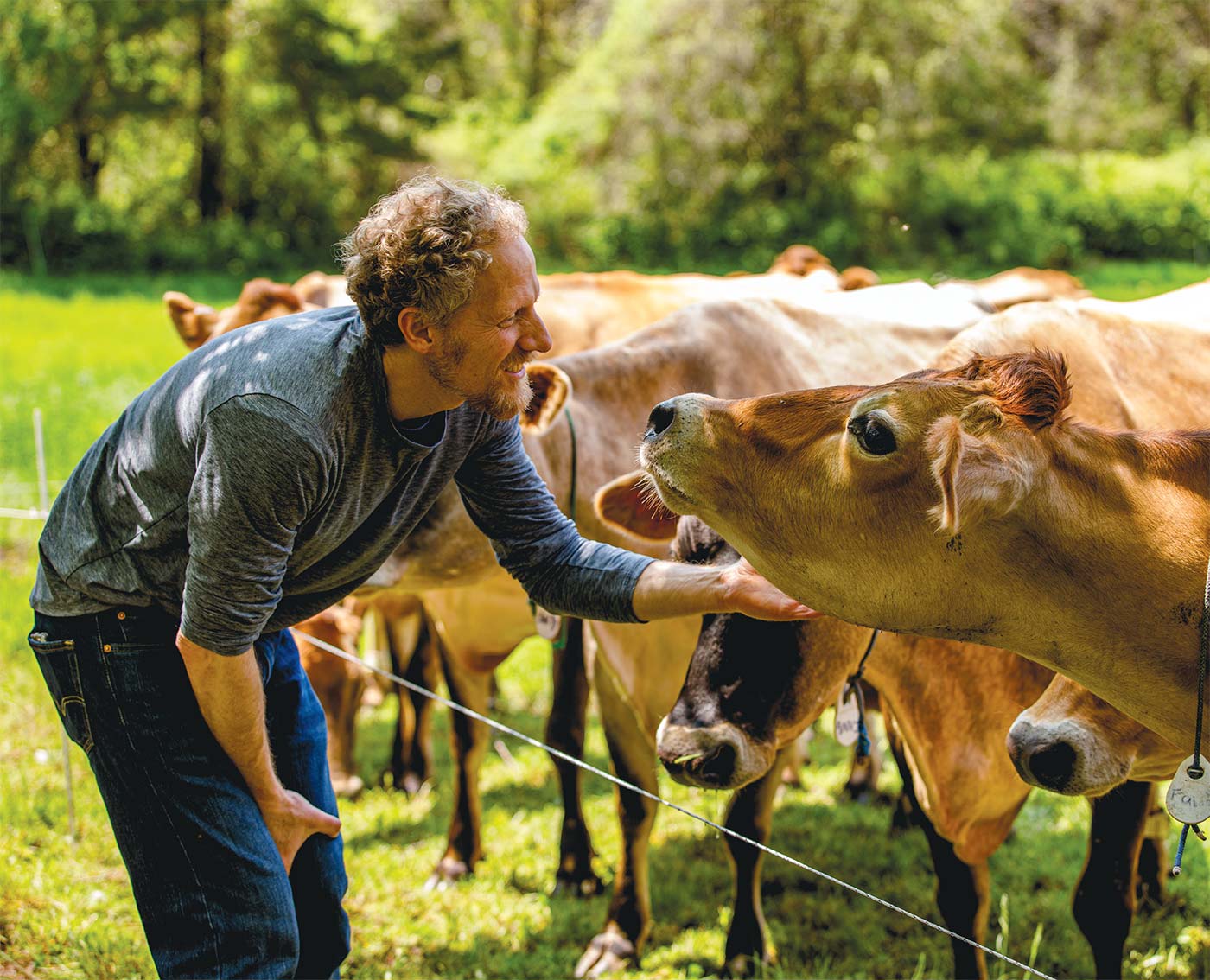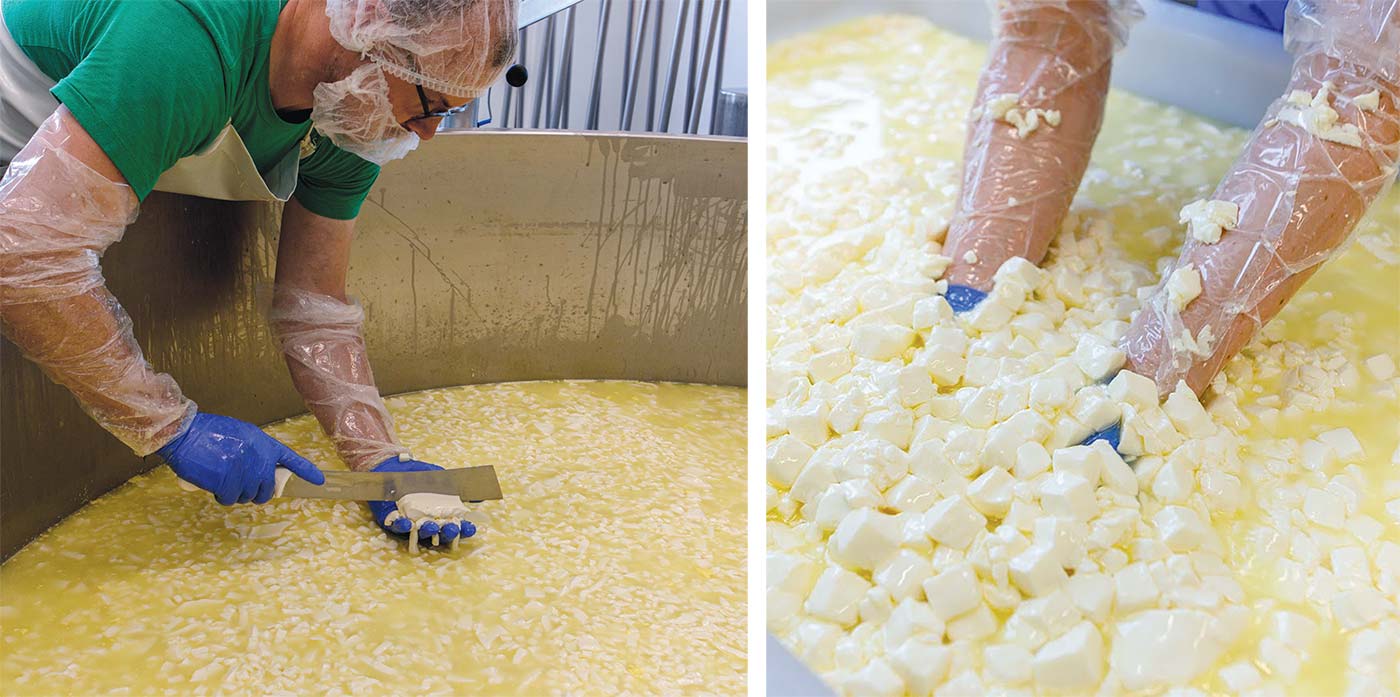Cato Corner Farm: The Art of Farmstead Cheesemaking

Mark coring cheese in the farm's cheese cave. PHOTOS LISA NICHOLS & FRANK MARCHESE
“Something old, something new, something stinky, something blue.” —Mark Gillman
Along the peaceful winding roads of Colchester, Connecticut, you’ll find Cato Corner Farm. The 75-acre farm is owned and operated by the mother and son team of Elizabeth MacAlister and Mark Gillman. “My Mom always wanted a farm. As a kid, she had goats, and sheep, and chickens. Then, we bought this piece of property in 1979 from a retiring dairy farmer. She had the chance to raise a few more animals. At one time, we had as many as 100 sheep and 40 goats in the 1980s. But ultimately, that never was a business that could support itself,” Mark explains.
“Then, in the 1990s, the Connecticut Department of Agriculture began promoting value-added products for dairy farms. Cheesemaking provided an opportunity to make a living as a farmer,” Mark continues. “In 1997, my mother took out a loan to put in a milking parlor and to purchase some used cheesemaking equipment. She started out milking just 13 cows to make cheese and sold it at local farmers markets. I was a schoolteacher in Baltimore at the time but decided to come back home to help my Mom in 1999. That year, we received a Connecticut Department of Agriculture grant to put in the cheese cave. It was a matching grant that helped build the underground bunker where all our raw-milk aged cheeses are aged.”
In addition to crafting cheese, protecting the land is a top priority at Cato Corner Farm. The farm has a conservation easement on the farm held by the Connecticut Farmland Trust which ensures that the entire farm will be protected in perpetuity. Around half of the 75-acres of land is in pasture and is protected through the US Department of Agriculture (USDA) Natural Resources Conservation Service (NRCS) Grasslands Reserve Program.
Mark and Elizabeth have worked with USDA NRCS to ensure the highly erodible land is kept in good quality. “NRCS is very committed to erosion control and has helped us repair some roads and helped us with runoff. When we first started, the cows would go to one of our ponds, but that had the potential to beat down the banks and cause erosion. We’ve fenced off that area and created a wildlife zone which is an amazing space now. NRCS has helped us install waterers throughout the paddocks which is a moveable watering system so that we can provide water where the cows are grazing. We’ve done lots with NRCS to help improve our management practices,” Mark explains.
Cato Corner Farm uses rotational grazing on all its pastures. The cows spend around 12 hours eating down the grass in small paddocks. Then, they move to the next paddock. The cows can select the grasses they want. This style of grazing gives the field time to recover after the cows have been there. This also enables the cows to have a grass-fed diet that is rich in nutrients.
Pasture season runs from around May 1st to November 15th. Cato Corner Farm feeds local hay to the cows throughout the winter. Elizabeth and Mark work with a nutritionist to see what nutritional needs are not being met from the grass and hay, and they supplement the cows’ diet with small amounts of grain and minerals.
Cato Corner Farm typically has around 80-90 animals on the farm at any point and will milk between 40-50 cows year-round. Their herd is comprised of Jersey cows. Jersey cows are a heritage breed that originated on the Isle of Jersey off the coast of the United Kingdom. Eventually, Jersey cows were exported and can now be found in many parts of the world. Elizabeth and Mark have been breeding their Jersey cows for A2:A2 milk production which can be easier for many people to digest.
“Jersey cows are great for cheesemaking. First, they are very sweet animals. They are lovely to work with and are personable. They are also slightly smaller and are easier in that sense. They are very gentle and beautiful animals. The Jersey cows also create milk that is high in butterfat protein which makes good cheese. If you look at the amount you spend to feed versus the cheese they produce, they are one of the most efficient cow breeds there is,” states Mark.

Mark showing the girls some love

From left: Chris slicing blue curd in the vat; Lily stirring Gossamer curds
According to the National Historic Cheesemaking Center in Monroe, Wisconsin, cheesemaking began 8,000 – 10,000 years ago. The Roman Empire helped spread cheesemaking throughout Europe from around 27 BC to 476 AD. The International Food Association states that during the Middle Ages, the art of cheesemaking was preserved and refined by monks living in monasteries throughout Europe. Some of the world’s most famous cheeses such as Münster and Parmigiano have monastic origins.
Cato Corner Farm crafts a unique range of farmstead cheeses. According to The American Cheese Society, farmstead cheeses are “made with milk from the farmer’s own herd, or flock, and aged on the farm where the animals are raised.” You’ll find Cato Corner Farm’s twists on timeless classics.
“A large part of our businesses is direct-to-consumer, so we’ve tried to create a mini cheese shop. I like to say, ‘something old, something new, something stinky, something blue,’” Mark shares. “When we started, all our cheeses were made from raw milk. The raw milk cheeses are aged 60-days to a year or more. Around 95% of our cheeses are still raw milk, but we are making some pasteurized cheeses now. The pasteurized cheeses can be served in a few days to a few weeks’ time.
On the raw cheese side, Cato Corner Farm’s Dutch Farmstead is mild and creamy, the Vivace is Italian inspired, and the Dairyere is reminiscent of a Swiss Gruyere. One of their most famous cheeses is their Womanchego, a pun on Spanish Manchego. Rather than being made with sheep’s milk like a traditional Manchego, Cato Corner Farm’s version is made with cow’s milk. The Bloomsday and Aged Bloomsday have a cheddary sweetness and nuttiness while the Black Ledge Blue is strong and earthy. Cornerstone is truly one of a kind and is a native culture cheese where Mark and his team make the starter culture. The raw milk sours and forms a yogurt, then the yogurt is used as the starter culture for the next batch of cheese

Mark & Liz under a sycamore (photo Colin Sullivan); and Mark smelling Despearado in the cave
In 2016, the farm received two grants that helped Elizabeth and Mark expand their cheese plant for more efficient cheese making and to add a production room for pasteurized cheeses. The State of Connecticut Department of Agriculture awarded Cato Corner a Farm Transition Grant, while the USDA Rural Development Value- Added Producer Grant provided federal funding to strengthen the farm’s marketing and help introduce the new line of pasteurized cheeses. Their four pasteurized cheeses include their Arietta, which is a mozzarella style cheese available for a few weeks in the summer; Sofia which is a Bulgarian-style feta available year-round; Celeste which is a lactic bloomy rind cheese akin to those you may find in the Loire Valley; and Gossamer which is similar to a Camembert. They have cheeses for every cheeseboard!
The farm’s delicious cheese has not gone unnoticed and has received attention at the national level. The American Cheese Society has honored Cato Corner Farm with multiple awards. In 2021, Food and Wine Magazine named Cato Corner Farm one of the top 50 cheesemakers in the country. These accolades are well-deserved.
Mark graciously acknowledges all the people who are part of Cato Corner Farm’s success: “Raising dairy cows and making cheese is a lot of work. We are extremely grateful to all our staff who make that possible. We couldn’t do it with a lot of help. We’re also grateful to the community including all the people who supported directly to our 2017 crowdfunding which allowed us to expand our cheesemaking, and to everyone who comes to the farm, farmers’ markets, and local stores, and buys our cheese. It has allowed us to do the work that we love, so thank you!”
Thankfully, Cato Corner Farm will continue to preserve the land, take great care of their herd of Jersey cows, and produce the most delicious cheese for years to come!
- To purchase locally crafted cheeses from Cato Corner Farm, visit their farmstand at 178 Cato Corner Road, Colchester. Find them at local farmers markets, or shop online at www.catocornerfarm.com or www.healthyplaneat.com




